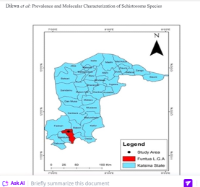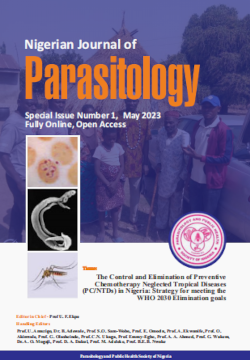Prevalence and Molecular Characterization of Schistosome Species Detected among Primary School Pupils around Gwaigwaye Reservoir, Funtua Local Government Area of Katsina State.
DOI:
https://doi.org/10.4314/njpar.v46i1.6Keywords:
Prevalence, Schistosome Species, Molecular, CharacterizationAbstract
Schistosomiasis, caused by Schistosoma haematobium and Schistosoma mansoni, causes morbidity and mortality throughout the African region, raising concerns about public health. This study was conducted to determine the prevalence and molecular characterization of schistosome species affecting primary school students in the Funtua Local Government Area of Katsina State. Pupils from five different primary schools in Gwaigwaye were randomly selected to provide urine and stool samples which were analyzed using sedimentation and formal ether concentration methods for S. haematobium and S. mansoni, respectively. Positive samples were characterized using Polymerase Chain Reaction. Data obtained were analyzed using GraphPad instant version statistical software package. The molecular characterization revealed the presence of two species of Schistosomes which were S. haematobium and S. mansoni. The results showed a prevalence of 35.8% and 15.3% for S. haematobium and S. mansoni, respectively. The highest prevalence of 36.1% and 16.9% were observed for S. haematobium and S. mansoni among age groups 10-15 years. Males had a higher prevalence of 40.4% and 19.3% for S. haematobium and S. mansoni than females who had 25.0% and 5.8%, respectively. The prevalence of both S. haematobium and S. mansoni infection vary significantly with respect to age and sex. Conclusively, this study showed that both S. haematobium and S. mansoni remain prevalent in the study area and appropriate control measures such as treatment of all infected individuals, should be employed to reduce the prevalence of both S. haematobium and S. mansoni.
References
World Health Organization (2016). Schistosomiasis: Number of people treated worldwide in 2014. Weekly epidemiological record, 91(5): 53-60. Accessed on 23 August 2016.
Biu, A. A., Nwosu, C. O. and Akuta, A. (2000). The incidence of human schistosomiasis in Maiduguri, northern Nigeria. Biological Science Research Communication, 12(1):9-11.
Nelwan, M. L. (2019). Schistosomiasis: Life cycle, diagnosis, and control. Current Thera Therapeutic Research, Clinical and Experimental, 91: 5–9. doi: 10.1016/j.curtheres.2019.06.001.
Chala, B. and Torben, W. (2018). Epidemiological trend of urinary schistosomiasis in Ethiopia. Public Health 2018.
Hotez, P. J., Asojo, O. A. and Adesina, A. M. (2012). Nigeria “Ground zero” for high prevalence. Neglected Tropical Disease, 6:54.
World Health Organization (2010). Schistosomiasis Fact Sheet; www.who.int/mediacentre/Factsheets.
Alemu, M., Zigta, E. and Derbie, A. (2018). Underdiagnosis of intestinal schistosomiasis in a referral hospital. North Ethiopia. BMC Res Notes, 11:245.
Sundaraneed, M. K., Tedla, B. A., Chenberger, R. M., Becker, L., Pickering, D. and Smout, M. J. (2017). Polypyridylruthium (1I) Complexes exert anti-schistosome activities and inhibit parasite Acetyl cholinesterases. PLoS Neglected Tropical Disease, 2017,11: 12.
Stothard, J. R. and Gabrielli, A. F. (2007). Response to Johansen et al.: Leave children untreated and sustain inequity. Trends Parasitology, 23(12):569-70.
Stothard, J. R., Sousa-Figueiredo, J. C., Betson, M., Bustinduy, A. and Reinhard- Rupp, J. (2013). Schistosomiasis in African infants and preschool children: let them now be treated. Trends Parasitology, 29 (4):197-205.
Makaula, P., Sadalaki, J.R., Muula, A.S., Kayuni, S., Jemu, S. and Bloch, P. (2014). Schistosomiasis in Malawi: a systematic review. Parasite and Vectors, 7:570.
Satrija, S. Y., Ridwan, S., Jastal, A. S., and Rauf, A. (2015). Current status of schistosomiasis in Indonesia. Acta Tropica, 141:349-353.
National Population Commission (NPC) (2016). Population of Katsina State, Funtua Local Government Area project,1.
Danrumpha, M. A. (2014). Spatial pattern of growth in Funtua. BSc project submitted to the Department of Geography and Environmental Management, ABU, Zaria. 1.
Cheesbrough, M. (1987). Medical Laboratory Manual for Tropical Countries Vol. 1, ELBS, Cambridge, Pp. 329-481.
Cheesbrough, M. (2006). District Laboratory practice in tropical countries. Cambridge: Cambridge University Press 2006.
Chen, M. G. and Mott, K. E. (1989). Progress in assessment of morbidity due to Schistosoma haematobium infection: a review of recent literature. Tropical Disease Bulletin, 86: R1-R36.
Cheesbrough, M. (1998). Medical Laboratory Manual for Tropical Countries. Part 1, Cambridge University Press, 1998.
Ochei, J. and Kolhatkzr, A. (2003). Medical Laboratory Science Theory and Practical. New Delhi: Tata McGraw-Hill; 2003.1, pp, 616-921.
Weerakoon, K. G. D., Gobert, G. N., Cai, P. and Mc Manus, D. P. (2015). Advance in the diagnosis of human schistosomiasis. Clinical microbiology, 28:939-967.
Ten-Hove, R. J., Verwerj, J. J., Verrecken, K., polma, K., Dieye, L. and Van Lieshout, L. (2008). Multiplex real-time PCR for detection and quantification of S. mansoni and S. haematobium infection in stool samples collected in northern Senegal. Tropical Medicine of Hygiene, 102:175-185.
Fuss, A,. Mazigo, H. D., Tappe, D., Kasang, C. and Muller, A. (2018). Comparison of sensitivity and specificity of three diagnostics to detect Schistosoma mansoni infections in school children in Mwanzer region Tanzania. Trans. R. Soc. 13: e0202499.
Webster, B. L., Rollinson, D., Stothard, J. R., and Huyse, T. (2010). Rapid diagnostic multiplex PCR (RD-PCR) to discriminate Schistosoma haematobium and S. Bovis. Journal of Helminthology, 84: 107-114.
Van den Broeck, F., Geldof, S., Polman, K., Volckaert, F. A. M., Huyse, T. (2011). Optimal samples storage and extraction protocols for reliable multilocus genotyping of the human parasite Schistosoma mansoni infection. Genetic Evaluation, 11: 1413-1418.
Cringoli, G., Rinaldi, L., Maurelli, M. P. and Utzinger, J. (2010). FLOTAC: new multivalent techniques for qualitative and quantitative copromicroscopic diagnosis of parasites in animals and humans. Nature Protocols, 5: 503–515.
Tavares, R. D., Staggemeier, R., Borges, A. L. P., Rodrigues, M. T., Castelan, L. A., Vasconcelos, J., Anscau, M. E., Spalding, S. M. (2011). Molecular techniques for the study and diagnosis of parasite infection. J. Venom. Anim. Toxins. Incl. Tropical Disease, 2011; 239-248.
Bawa, J. A., Auta, T., Msughter, I. and Umar, Y. A. (2016). Urinary Schistosomiasis among Primary School Children in Dutsin-Ma Town, Katsina State, Nigeria. Science Domain International,10(1): 1-8.
Ezeh, C. O., Onyekwelu, K. C., Akinwale, O. P., Shan, L. and Wei, H. (2009). Urinary Schistosomiasis in Nigeria: a 50 year review of prevalence, distribution and disease burden. Parasite, 26;19.
Chidozie, E. U. and Daniyan, S. Y. (2008). Urinary schistosomiasis epidemiological survey of urinary schistosomiasis among children in selected school: A preliminary study in Minna, Nigeria. African Journal of Biotechnology 7(16):2773-2776.
Olalubi, A. O., Olukunle, B. and Ologunde, F. (2013). Prevalence and risk factors of Schistosoma haematobium infections among primary school children in Igbokuta Village, Ikorodu North Local Government, Lagos State. IOSR Journal of Nursing and Health Science, 2(6): 62-68.
Shinkafi, B. Y., Adamu, T., Abdullahi, K., Manga, S. B. and Bala, A.Y. (2013). Schistosomiasis in Communities near Zobe Dam Dutsinma, Katsina State, Nigeria. Nigerian Journal of Parasitology, 34(1): 2.
Akpan, S. S., Dike, P. C. and Mbah, M. (2017). The Prevalence of urinary Schistosomiasis among school children in Nkarasi and Edor communities in Ikom Local Government Area of Cross River State, Nigeria. Pyrex Journal of Medicine and Medical Sciences, 4 (1):1-4.
Amuta, E. U. and Houmsou, R. S. (2014). Prevalence, intensity of infection and risk factors of urinary schistosomiasis in pre-school and school-aged children in Guma Local Government Area, Nigeria. Asian Pacific Journal of Tropical Medicine 7(1): 34-39.
Dawaki, S., Al-Mekhlafi, H. M., Ithoi, I., Ibrahim, J. (2016). Prevalence and risk factors of schistosomiasis among Hausa communities in Kano State, Nigeria. Journal of the Sao Paulo Institute of Tropical Medicine, 58:54.
Nwibani, B. M. W., Johnson, C. T., Yohanna, J. A. and Dakul, D. A. (2016). Prevalence of urinary schistosomiasis among Human Immuno-Deficiency Virus patients attending Faith Alive medical centre in Jos north, Plateau State, Nigeria. International Journal of Biomedical and Health Sciences, 12(1): 11-17.
Singh, K. and Muddasiru, D. (2014). Epidemiology of schistosomiasis in school-aged children in some riverine areas of Sokoto, Nigeria. Journal of Public Health and Epidemiology, 6(6): 197-201.
Landouré, A., Dembélé, R., Goita, S., Kané, M., Tuinsma, M., Sacko, M. (2012). Significantly reduced intensity of infection but persistent prevalence of schistosomiasis in a highly endemic region in Mali after repeated treatment. PLoS Neglected Tropical Disease 6 (7): e1774.
Houmsou, R. S., Panda, S. M., Elkanah, S. O., Garba, L. C., Wama, B. E., Amuta, E. U. and Kela, S. T. (2016). Cross-sectional study and spatial distribution of schistosomiasis among children in Northeastern Nigeria. Asian Pacific Journal of Tropical Biomedicine, 6(6): 477–484.
World Health Organization (1991). Basic laboratory method in medical parasitology. Geneva. Pp 33-36.
Anosike, J. C., Okafor, F. C., and Onwuliri, C. O. E. (1992). Urinary Schistosomiasis in Toro Local Government Area of Bauchi State. Nigeria. Helminthology, 29:177-179.

Downloads
Published
How to Cite
Issue
Section
License
Copyright (c) 2025 Nigerian Journal of Parasitology

This work is licensed under a Creative Commons Attribution-NonCommercial-NoDerivatives 4.0 International License.




